For the 2025 school year, there are 3 public preschools serving 573 students in RSU 34 School District. This district's average pre testing ranking is 3/10, which is in the bottom 50% of public pre schools in Maine.
Public Preschools in RSU 34 School District have an average math proficiency score of 77% (versus the Maine public pre school average of 79%), and reading proficiency score of 80% (versus the 82% statewide average).
Minority enrollment is 13% of the student body (majority Hispanic), which is less than the Maine public preschool average of 14% (majority Black).
Overview
This School District
This State (ME)
# Schools
5 Schools
259 Schools
# Students
1,403 Students
59,048 Students
# Teachers
129 Teachers
5,438 Teachers
Student : Teacher Ratio
11:1
11:1
District Rank
RSU 34 School District, which is ranked within the bottom 50% of all 191 school districts in Maine (based off of combined math and reading proficiency testing data) for the 2021-2022 school year.
The school district's graduation rate of 82% has increased from 75-79% over five school years.
Overall District Rank
#130 out of 222 school districts
(Bottom 50%)
(Bottom 50%)

Math Test Scores (% Proficient)
81%
82%
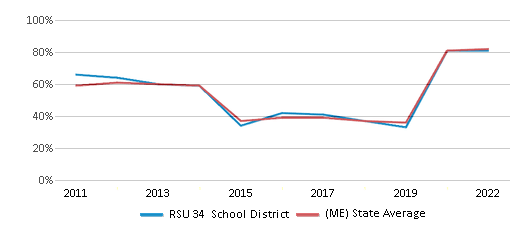
Reading/Language Arts Test Scores (% Proficient)
81%
84%
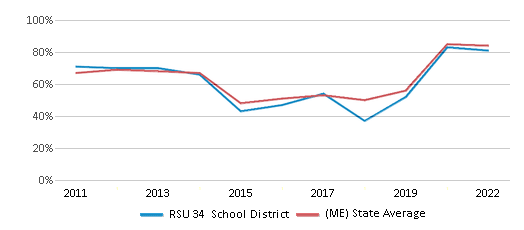
Science Test Scores (% Proficient)
32%
37%
Graduation Rate
82%
86%
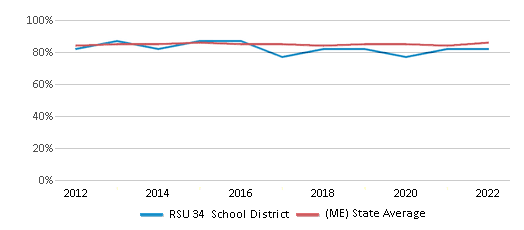
Students by Ethnicity:
Diversity Score
0.24
0.26
# American Indian Students
19 Students
341 Students
% American Indian Students
1%
1%
# Asian Students
12 Students
561 Students
% Asian Students
1%
1%
# Hispanic Students
44 Students
1,995 Students
% Hispanic Students
3%
3%
# Black Students
25 Students
3,146 Students
% Black Students
2%
5%
# White Students
1,222 Students
50,694 Students
% White Students
87%
86%
# Hawaiian Students
1 Student
47 Students
% Hawaiian Students
n/a
n/a
# Two or more races Students
80 Students
2,264 Students
% of Two or more races Students
6%
4%
Students by Grade:
# Students in PK Grade:
45
6,275
# Students in K Grade:
82
9,065
# Students in 1st Grade:
96
8,751
# Students in 2nd Grade:
79
8,998
# Students in 3rd Grade:
87
7,460
# Students in 4th Grade:
97
6,832
# Students in 5th Grade:
87
5,562
# Students in 6th Grade:
88
2,965
# Students in 7th Grade:
102
1,380
# Students in 8th Grade:
94
1,417
# Students in 9th Grade:
135
82
# Students in 10th Grade:
142
89
# Students in 11th Grade:
133
86
# Students in 12th Grade:
136
86
# Ungraded Students:
-
-
District Revenue and Spending
The revenue/student of $19,394 in this school district is less than the state median of $21,600. The school district revenue/student has stayed relatively flat over four school years.
The school district's spending/student of $17,523 is less than the state median of $21,191. The school district spending/student has stayed relatively flat over four school years.
Total Revenue
$27 MM
$3,617 MM
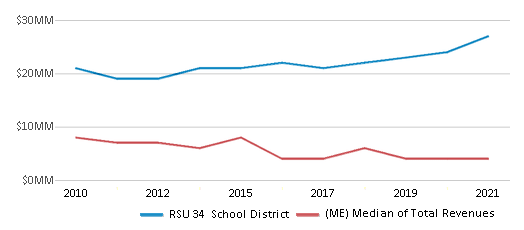
Spending
$25 MM
$3,549 MM
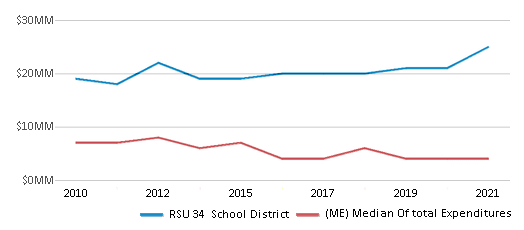
Revenue / Student
$19,394
$21,600
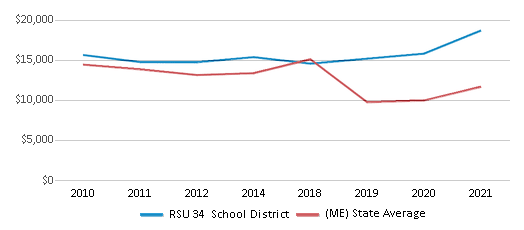
Spending / Student
$17,523
$21,191

Best RSU 34 School District Public Preschools (2025)
School
(Math and Reading Proficiency)
(Math and Reading Proficiency)
Location
Grades
Students
Rank: #11.
Alton Elementary School
(Math: 80-89% | Reading: 80-89%)
Rank:
Rank:
6/
Top 50%10
22 Argyle Rd
Old Town, ME 04468
(207) 394-2331
Old Town, ME 04468
(207) 394-2331
Grades: PK-3
| 57 students
Rank: #22.
Old Town Elementary School
(Math: 76% | Reading: 79%)
Rank:
Rank:
2/
Bottom 50%10
576 Stillwater Avenue
Old Town, ME 04468
(207) 827-1544
Old Town, ME 04468
(207) 827-1544
Grades: PK-5
| 476 students
Rank: n/an/a
55 Highland Avenue
Bradley, ME 04411
(207) 827-2508
Bradley, ME 04411
(207) 827-2508
Grades: PK-1
| 40 students
Recent Articles

Year-Round Or Traditional Schedule?
Which is more appropriate for your child? A year-round attendance schedule or traditional schedule? We look at the pros and cons.

Why You Should Encourage Your Child to Join a Sports Team
Participating in team sports has a great many benefits for children, there is no doubt. In this article you will learn what those benefits are.

White Students are Now the Minority in U.S. Public Schools
Increasing birth rates among immigrant families from Asia and Central and South America, combined with lower birth rates among white families, means that for the first time in history, public school students in the United States are majority-minority. This shift in demographics poses difficulties for schools as they work to accommodate children of varying language abilities and socio-economic backgrounds.





